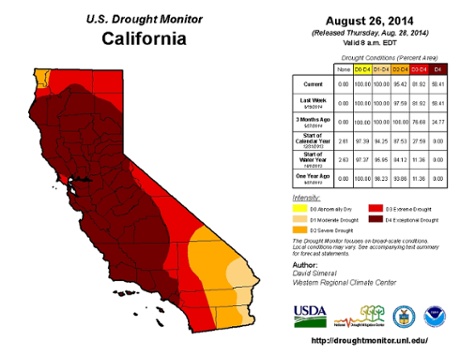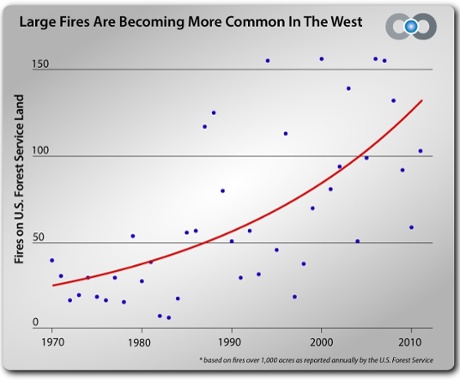 Departure of the November 2013 – January 2014 250 hPa geopotential height from the normal climatology. Source: Wang et al. (2014), Geophysical Research Letters Photograph: Wang et al. (2014), Geophysical Research Letters
Departure of the November 2013 – January 2014 250 hPa geopotential height from the normal climatology. Source: Wang et al. (2014), Geophysical Research Letters Photograph: Wang et al. (2014), Geophysical Research LettersConnecting the dots between human-caused global warming and specific extreme weather events has been a challenge for climate scientists, but recent research has made significant advances in this area. Links have been found between some very damaging extreme weather events and climate change.
For example, research has shown that a “dipole” has formed in the atmosphere over North America, with a high pressure ridge off the west coast, and a low pressure trough over the central and eastern portion of the continent.
 Departure of the November 2013 – January 2014 250 hPa geopotential height from the normal climatology. Source: Wang et al. (2014), Geophysical Research Letters Photograph: Wang et al. (2014), Geophysical Research Letters
Departure of the November 2013 – January 2014 250 hPa geopotential height from the normal climatology. Source: Wang et al. (2014), Geophysical Research Letters Photograph: Wang et al. (2014), Geophysical Research Letters
These sorts of pressure ridges in the atmosphere are linked to “waves” in the jet stream. Research has shown that when these jet stream waves form, they’re accompanied by more intense extreme weather. The high pressure zone off the west coast or North America has been termed the “Ridiculously Resilient Ridge” due to its persistence over the past two years. It’s been the main cause of California’s intense drought by pushing rain storms around the state.
 California drought as of 26 August 2014. 58% of the state is in ‘exceptional drought’ conditions. Source: United States Drought Monitor
California drought as of 26 August 2014. 58% of the state is in ‘exceptional drought’ conditions. Source: United States Drought Monitor
A paper led by S.-Y. Wang of Utah State University found the high pressure ridge is linked to a precursor of the El Niño Southern Oscillation (ENSO), but also that human-caused global warming has amplified the strength of these ridges. The authors concluded,
It is important to note that the dipole is projected to intensify, which implies that the periodic and inevitable droughts California will experience will exhibit more severity.
Similarly, a recent paper led by Kevin Trenberth and published in Nature Climate Change concluded,
Increased heating from global warming may not cause droughts but it is expected that when droughts occur they are likely to set in quicker and be more intense.
Another study recently published in the Journal of Climate examined data from past climate changes, and found that climate models are underestimating the likelihood of intense droughts in the southwestern USA due to global warming.
In the US Southwest, for instance, state-of-the-art climate model projections suggest the risk of a decade-scale megadrought in the coming century is less than 50%; our analysis suggests that the risk is at least 80%, and may be higher than 90% in certain areas. The likelihood of longer lived events (> 35 years) is between 20% and 50%, and the risk of an unprecedented 50 year megadrought is non-negligible under the most severe warming scenario (5-10%).
There are several ways in which global warming intensifies drought. Hotter temperatures increase evaporation from soil and reservoirs. They cause more precipitation to fall as rain and less as snow, which for a region like California that relies on the snowpack in the Sierra Nevada mountains as its natural water storage system, is problematic. Hotter temperatures also cause the snowpack to melt earlier in the year. The problem can be alleviated by building more water storage infrastructure, but that costs money.
On top of all that, there’s the apparent strengthening of high pressure ridges off the coast, pushing rain storms around California. Research suggests that there may be a connection between these ridges and the decline in Arctic sea ice, although this connection is debated among climate experts.
California is the biggest agricultural producer in the USA, and exported $18 billion of agricultural products to the world market in 2012. The state leads the USA in 79 different crop and livestock commodities ranging from artichokes to olives to walnuts. When California agriculture takes a hit due to drought amplified by global warming, it has costs across the country and around the world in the form of higher food prices. A report out of UC Davis also estimated the drought’s cost to the state in 2014 at $2.2 billion.
Much of those costs are related to increased pumping of groundwater. So much groundwater has been pumped over the past 18 months that a recent study found that California has a 63 trillion gallon groundwater deficit. Due to this depletion of groundwater, which is heavy and depresses the planet’s crust, the Sierra Nevada mountains are now up to 15 mm higher than before the drought. The reduced stress on the San Andreas fault has also made earthquakes more likely in California.
Droughts and global warming are also connected to wildfires. Hotter, drier temperatures create conditions ripe for large fires, which have become more common in the western USA over the past four decades.
 Annual number of wildfires greater than 1,000 acres on U.S. Forest Service Land. Source: Climate Central Photograph: Climate Central
Annual number of wildfires greater than 1,000 acres on U.S. Forest Service Land. Source: Climate Central Photograph: Climate Central
A 2011 study published in the journal Climatic Change estimated that in a business-as-usual scenario with continued reliance on fossil fuels, by 2085 the annual area burned by wildfires in California will increase by 40–70% as compared to 1975. If we take serious action to reduce human-caused global warming, the annual area burned can be limited to a 15–30% increase in 2085.
Most of this increase is projected to happen in northern California, where air pollution from those fires tends to collect in the Central Valley, causing adverse health impacts. The property damage caused by the fires, firefighting efforts, and health effects all have significant costs.
Climate scientists have been working on teasing out the global warming contributions to various extreme weather events. They’ve determined that global warming made several specific weather events more likely and/or more extreme; particularly heat waves and flooding.
Peter Stott of the UK Met Office is leading a new project called European Climate and Weather Events: Interpretation and Attribution (EUCLEIA). The idea is to run climate simulations with and without a human-caused global warming component, to see how much more likely climate change has made a particular type of extreme weather event.
Posted by dana1981 on Tuesday, 2 September, 2014
 |
The Skeptical Science website by Skeptical Science is licensed under a Creative Commons Attribution 3.0 Unported License. |